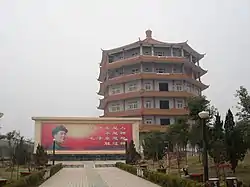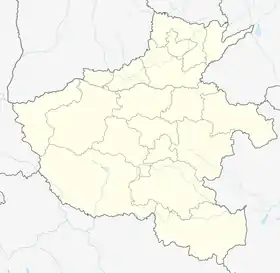Nanjie
Nanjie (Chinese: 南街村; pinyin: Nánjiē Cūn) is a village under the administration of the town of Chengguan, Linying County, Henan.[1][2] It is widely reported as being the last Maoist village in China, and has attracted considerable global attention due to its unique political and economic system.[3][4][5][6] The village has an area of 1.78 square kilometres (0.69 sq mi),[7] and has about 3,400 permanent residents as of 2011.[5]
Nanjie
南街村 | |
|---|---|
 | |
 Nanjie Location in Henan | |
| Coordinates: 33°48′09″N 113°57′27″E | |
| Country | People's Republic of China |
| Province | Henan |
| Prefecture-level city | Luohe |
| County | Linying |
| Town | Chengguan |
| Government | |
| • Party Committee Secretary | Wang Hongbin (Chinese Communist Party) |
| Area | |
| • Total | 1.78 km2 (0.69 sq mi) |
| Population (2011) | |
| • Total | 3,400 |
| • Density | 1,900/km2 (4,900/sq mi) |
| Time zone | UTC+8 (China Standard) |
| Postal code | 411122 |
| Telephone area code | (0)395 |
History
In 1979, village leader Wang Hongbin, who had been instated two years prior,[4][5] and his colleagues pooled money to visit a neighbouring county to learn how to start a factory.[7] After the trip, Wang and said colleagues established a flour mill and brick factory in Nanjie.[7] In subsequent years, Wang would frequent Beijing to sell the village's flour and to earn manufacturing contracts.[7] From 1981 to 1984, the village trialed China's household responsibility system, where the village's land and factories were privatized, but Nanjie officials reported that such a system resulted in a decline in agricultural output, an increase in crime, and general hostilities in the village.[7] Following the re-collectivisation of Nanjie, the village saw its economy grow exponentially, and the village's government began supplying its villagers with free electricity, food, water, tuition, furnished apartments, healthcare, and life insurance.[7] During the early 1990s, the village began attracting political attention from officials throughout Henan, which enabled it to gain large loans for new projects.[7] Simultaneously, Nanjie began employing workers from outside the village in large numbers.[7]
Politics
The village is headed by Wang Hongbin, who has headed the village since 1977.[4][5] Wang has adopted the title of ban zhang (simplified Chinese: 班长; traditional Chinese: 班長), which translates as "class monitor" or "squad leader", due to it being the lowest title an official can take.[5]
Public portraits and statues of Karl Marx, Friedrich Engels, Vladimir Lenin, Joseph Stalin, and Mao Zedong are common throughout the village, and their images are highly celebrated.[4][5] Nanjie and many other Maoist villages attract people opposing elements of capitalism, disgruntled old retired party cadres, new left intellectuals, and pro-Maoist protesters.[8]
Judicial punishments in the village include mandatory "study classes" (simplified Chinese: 学习班; traditional Chinese: 學習班; pinyin: xué xí bān), public denunciation, and expulsion from the village.[7] Wang Hongbin himself underwent public denunciation after investing tens of millions of Yuan into a failed "perpetual motion machine" project which shut down in 2011.[9] A 2002 paper also reported that corporal punishment has been used in the village.[7]
Economy
.jpg.webp)
Nanjie collectivised its agricultural production and industry in 1986, a time when the rest of the country was doing the opposite, introducing market reforms put forward by former leader Deng Xiaoping.[5] This followed a short four-year stint of privatization under China's household responsibility system.[7] The village has inspired a number of other villages in the country to re-collectivise.[4]
The village operates the Nanjie Village Group, which offers all villagers employment in its various workplaces.[9] The group pays village residents 30% of their salary in cash, and puts the remaining 70% of their salary in public services.[9]
By 1990, Nanjie reported a gross domestic product of ¥47.00 million, which rose to over ¥103 million in 1991, ¥212.69 million in 1992, and ¥802.00 million in 1994.[7] Over the next four years, the village's output nearly trebled to ¥1.8 billion.[7] However, from 1998 to 2007, the village saw its gross domestic product fall over 20% down to just over ¥1.4 billion, and by 2007, the village's debt to GDP ratio exceeded 100%.[7]
Nanjie hosts a number of factories and flour mills, and produces a number of foodstuffs, such as instant noodles and beer.[4]
Labour
The village attracts a large number of commuters from surrounding areas, which represent two or three times the local population.[4][5] These commuters are not a part of the village's collectivization program, but receive a month salary along with free meals and a dormitory.[4][5] The village's heavy reliance on those who live elsewhere has drawn criticism from the Southern Metropolis Daily, which ran a piece in 2008 accusing Nanjie's economy being propped up by cheap labourers who live elsewhere, and through large loans awarded by Communist Party officials.[5]
One migrant labourer reported that migrants work 12-hour days, and are required to attend "political study sessions" after work.[7]
Tourism
The village receives a significant amount of red tourism from visitors throughout China.[4]
References
- 2016年统计用区划代码和城乡划分代码:城关镇 [2016 Statistical Area Numbers and Rural-Urban Area Numbers: Chengguan Town] (in Simplified Chinese). National Bureau of Statistics of the People's Republic of China. 2016. Retrieved 13 July 2018.
411122100219 122 南街村委会
- 城关镇 [Chengguan Town] (in Simplified Chinese). XZQH.org. 24 March 2009. Retrieved 13 July 2018.
[代码]411122100:{...}~219南街村{...
} - Cheng, Tony (2008-06-25). "China's last Maoist village". Al Jazeera English. Archived from the original on 2021-12-21. Retrieved 2008-06-26.
- Markus, Francis (2002-11-19). "Chinese village still in Mao era". BBC News. Archived from the original on 2019-08-27. Retrieved 2011-06-24.
- Wong, Edward (2011-06-24). "In China, a Place Where Maoism Still Reigns". New York Times. Archived from the original on 2019-03-28. Retrieved 2011-06-24.
- Kessel, Jonah M. (2011-06-24). "Video: The Reddest Village in China". The New York Times. ISSN 0362-4331. Retrieved 2023-09-02.
- Feng, Shizheng; Su, Yang (2013). "The making of Maoist model in post-Mao era: The myth of Nanjie village" (PDF). Communist and Post-Communist Studies. 46: 39–51. Archived from the original (PDF) on 2019-04-29.
- Feng, Shizheng; Su, Yang (2013). "The making of Maoist model in post-Mao era: The myth of Nanjie village". Communist and Post-Communist Studies. 46 (1): 39–51. doi:10.2307/48610372. ISSN 0967-067X. Retrieved 11 December 2022.
- Fu, Danni; Wang, Yiwei (2018-12-20). "China's Collective Villages Struggle to Keep It Together". Sixth Tone. Archived from the original on 2020-01-28. Retrieved 2020-10-26.